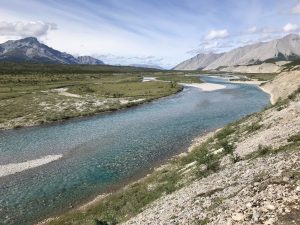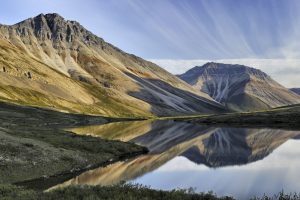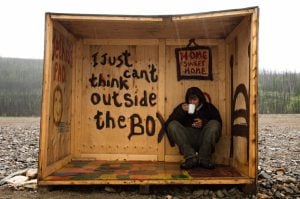
Exploration
Return to the Peel
We came to retrace an ancestor’s 1905 map-making expedition of the Peel River watershed. We left with a new-found appreciation of what this ancient land means to the people who live there.
- 2676 words
- 11 minutes
This article is over 5 years old and may contain outdated information.
Environment

When the Yukon government announced in January that 71 per cent of the territory’s Peel River watershed region would be open to mining, conservation and First Nations groups were shocked.
Many had hoped that the government would follow the Peel Watershed Planning Commission’s recommendation that as much as 80 per cent of the almost 70,000- square-kilometre wilderness area be withdrawn from industrial development, including mineral staking.
Instead, the land will be separated into three categories: protected areas (29 per cent); restricted use wilderness areas (44 per cent), which the territorial government says, “allows for low levels of carefully managed land use activity”; and integrated management areas (27 per cent), where “most land use activities may occur.” The government says that in the last two areas “mineral staking and proposed commercial activities will be subject to enhanced regulatory and permit processes.”

“The plan recognizes existing mineral interests and accommodates future exploration, while giving the Yukon government the tools to manage the footprint of any new development and to protect ecological, cultural and wilderness values,” Minister of Energy, Mines and Resources Scott Kent said in a statement.
But that assurance wasn’t enough for many, and in the days following the announcement the government found itself facing a lawsuit over its decision. During this time, Canadian Geographic received several letters from those affected — or affronted — by the government’s plan. Many were addressed to Yukon Premier Darrel Pasloski. Listed below are excerpts from some of them.
The watershed is a huge area situated in the Yukon, but you must understand that all tributaries connect and flow through parts of the Northwest Territories and eventually right by Aklavik, our home. We are thinking beyond any short-term benefits and looking long-term, for our future generations.
—124 residents of Aklavik, N.W.T.
This is to let you know how disappointed I am with your decision. You’re destroying what makes the Yukon so special. You’re not serving us — you’re ruling us, which isn’t very democratic, and we’re paying your salary! I am asking you to reverse your decision and leave a legacy you can be proud of. There’s more to life than money.
—Ian P. Smith, Whitehorse
I’m utterly flabbergasted at the short-sightedness of this government’s decision-making — selling out one of the last great intact ecosystems for greed and short-term job security. Are any of the decision makers involved actually educated in life sciences? Or do these government representatives speak only for the corporations whose only understanding is “more”?
—Ernest McCrank, Vancouver
I have experienced the traditions of the First Nations, witnessed first-hand the beauty of the Yukon and fully comprehend the value and importance of the land to the native peoples of the area. I have also lived in Fort McMurray, and seen the devastation caused by operations such as oil extraction. Considering the irresponsibility and lack of accountability that is commonplace within large industrial companies, it is extremely unlikely and unrealistic to expect any plans of development to be carried out the “right” way, rather than the “cost effective” way.
—Jacob Alexander, Wolfville, N.S.
We are a group of concerned First Nation youth from the Yukon. When we think of the words of our ancestors, “Together today for our children tomorrow,” we think of those who have come before us, and the vision they carried for the lands we all call home, the Yukon. It’s our responsibility to uphold these words and carry this vision forward. Our elders tell us, “You do things in a good way, and if you take care of the land, it will take care of you.” It’s hard to understand how and why the current Yukon government continues to do the contrary.
—[email protected]
I understand that society requires and uses non-renewable resources (although often in an unsustainable and wasteful manner) and that extraction projects require a significant time frame to go from exploration to development. Nevertheless, keeping the minerals and resources in the ground preserves their potential availability to future generations. Rushing to extract as much as possible for short term political and/or economic gain is not morally right and makes no sense from a planning perspective for long-term sustainability.
—Brian Charles, Whitehorse
Are you passionate about Canadian geography?
You can support Canadian Geographic in 3 ways:

Exploration
We came to retrace an ancestor’s 1905 map-making expedition of the Peel River watershed. We left with a new-found appreciation of what this ancient land means to the people who live there.

Environment
To many, the Yukon appears to be the vanguard of a growing Indigenous land power movement in Canada centred mostly in the North

Travel
An insider’s account of the modern-day gold rush

Environment
David Boyd, a Canadian environmental lawyer and UN Special Rapporteur on Human Rights and the Environment, reveals how recognizing the human right to a healthy environment can spur positive action for the planet